
In this blog-interview series, we present the Radboudumc Technology Centers (RTCs) – your gateway to technological expertise, state-of-the-art equipment, and invaluable resources. In each part we spotlight one of the 19 RTCs housed within our organization.
-
Today, I am visiting an RTC that facilitates one of the most debated aspects of science: animal research! This facility, better known in Dutch as the 'Centraal Dierenlaboratorium (CDL)', was founded on January 1st, 1955, with the simultaneous appointment of Dr. M.J. Dobbelaar as its first director and employee. Initially, it was nothing more than a modest shed. Dobbelaar’s ambition, however, was to establish a central animal facility to enhance the knowledge of human health and disease with studies in laboratory animal models. His efforts led to Europe's first Central Animal Laboratory in 1960, situated on our campus. At that time, he was a true pioneer and visionary.
Anno 2024, as we are approaching its 70th anniversary, the tide has been changing for animal research. There is more focus on animal welfare and how to further reduce discomfort. This year’s InScience Filmfestival, for instance, included a discussion session with Radboudumc researcher(s) around the documentary ‘Fauna’. The position and policy of Radboudumc regarding animal research can be found here.
The main purpose of this blog series is to provide an overview of the services our RTC's provide, and I’ll surely cover that. Yet, I am curious how the animal research facility (CDL) is operating under these challenging conditions, and what stops us from discontinuing the use of laboratory animals. I wonder whether we can truly progress towards a science devoid of laboratory animals, as the government aims with its recent funding of 125 million Euros, or if we still need them for at least a while? What are the alternatives and how are the actual conditions for these animals? Let’s go ahead to the neighboring CDL building to see if I can find answers to these and other questions.
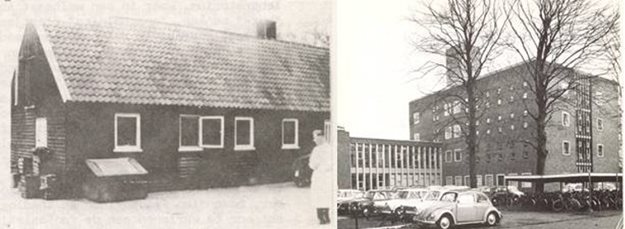
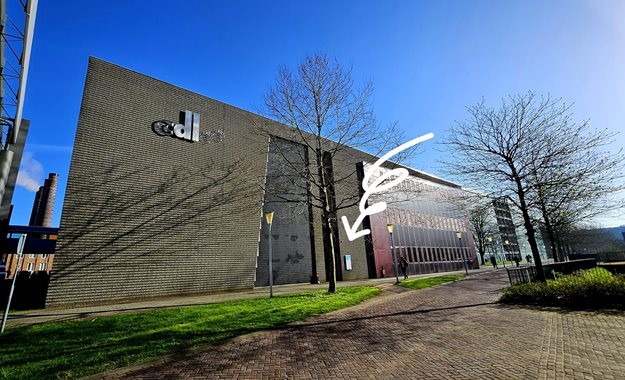
Top: Former CDL buildings, on the left as it was in 1955 and on the right in 1960. Bottom: The current ’Centraal Dierenlaboratorium‘ (CDL) building, which was constructed in 1997.
-Ah, the long-awaited spring is finally here! Longer days, chirping birds, colorful blooms everywhere. A new cycle of life! Walking through the gate of the CDL building, I suddenly find myself in the middle of a charming triangular garden with artistic touches, a serene pond, and lush greenery.
Assuming that the entrance is inaccessible for me, I approach the intercom button, only to discover, to my surprise, that the door isn't locked at all. I step inside and navigate through the building until I finally locate Otto's office. And before I can enter the room, I hear a friendly greeting.
"Hasan! Come on in!”
“Hi Otto! Thank you very much. Did I just have some good luck, or can anyone get in and out the building this freely?”
“It’s indeed not much different than any other building here on our campus. Transparency is our key principle. Almost every part of this building is freely accessible, except some restricted areas to ensure the microbiological hygiene of our animals. Please take a seat!”
“Thanks! I know you are the director of the RTC Animal Research Facility, but can you tell a bit more about yourself?”
"I'm Otto Boerman! Before I took on the role of director at the Animal Research Facility, a position opened up in 2017, I've led my own research group here at Radboudumc. In my research group, we used to conduct lots of experiments with laboratory animals. In 2017, the position of director of the CDL became vacant for which I applied. My appointment marked the beginning of a new RTC: The RTC Animal Research Facility. (ed. Due to his early retirement, this position is now vacant again!)”
"Before we go any further, let's clarify something: what kind of animals are we talking about when we say laboratory animals? Could that be any animal?”
“No, typically, when we refer to laboratory animals, we're talking about vertebrates. This encompasses a wide range of species, such as rabbits, chicken, pigs, sheep, goats and llamas. At our facility, however, the vast majority (>95%) of laboratory animals are rats or mice.
The CDL offers facilities and expertise for investigators to plan and carry out experiments with laboratory animals. Most of our facilities are located in the CDL building on the Radboudumc campus at Geert Grooteplein 29. We also have a location in Overasselt where mice and rats for experiments are bred and where barnyard animals such as sheep and chickens are housed.”
“On April 24, it was World Day for Laboratory Animals. I am not sure whether the annual protests took place again, but how do you work and operate under these circumstances? Aren't you afraid of potentially negative publicity?”
“It's definitely not an easy job to be under constant scrutiny, but our philosophy is that animal research these days can only be done with maximum openness and transparency. We have nothing to hide. On the contrary, we aim to demonstrate to all people who are interested in studies with laboratory animals why and how these studies are carried out. In terms of animal welfare, we do more than we are obliged to do. Every animal is assigned a barcode that allows us to track all procedural details. And with respect to transparency, we make each detail of every single animal experiment available online. That puts us in a unique position in the Netherlands, along with Utrecht University.
Moreover, we organize about 100 lab tours every year, from individual journalists to larger groups of people. Last year, we even organized a tour for primary school children. That required some creativity, but it was quite a success. And, at least once a year, we also host people from Animal Rights and proefdiervrij.”
“Do they leave satisfied?”
“Of course, we don't agree on every aspect with these organizations, and they do not leave us with full satisfaction, but we usually arrive at mutual understanding. People are sometimes shocked by the amount and complexity of all the rules and regulations associated with animal research.”
“Such as?”
“Think of the minimum size and dimensions required for animal cages, or the need for social interactions and cage enrichments, to name a few. In fact, experiments with laboratory animals are only carried out when four requirements are fulfilled:
- The research question cannot be answered based on data from the current scientific literature
- Alternative methods without the use of laboratory animals cannot be used to answer the question
- Two independent committees, the Animal Research Committee (Dierexperimentencommissie (DEC)) and the Central Committee on Animal Experiments (Centrale Commissie Dierproeven (CCD)), have approved the study
- The 3 R’s (replacement, reduction, and refinement) have been applied in the design of the experiment
Anyway, why don’t I show you the facility?”
“Sure, I am happy to follow your lead!”
Text continuous after image
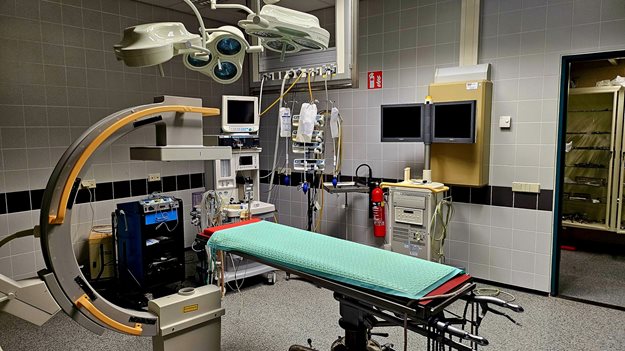
The operating room of the RTC Animal Research Facility
We leave the room and walk along the corridors. Our first stop is the Animal Operating Room (OR). At first glance, the room is not much different from a human OR. I am being told that this is the place where large animals undergo surgery.
“Above us, on the first floor, our Translational Neuroscience Unit is located, supporting neuroscience research with mice and rats, offering equipment to measure cognition, emotion, social behavior, motor-related function, and sensory function. At this moment, and although not falling under the category of laboratory animals, research with malaria mosquitos is also being conducted at our facility.”
After observing the OR for some time, we proceed to descend the stairs to the basement level. Once entered the stairwell, I notice the wall decorations, with shapes and drawings of animals that remind me of old Egyptian drawings.
“And now we are at the basement level where our Preclinical Imaging Center (PRIME) is housed. Here, we provide advanced imaging equipment, including CT, PET, SPECT, fluorescence imaging, and bioluminescence imaging. We have MRI scanners, as strong as 7 or even 11.7 Tesla, which is quite strong for human standards."
We stop in front of a glass wall, behind which a giant yellow robot arm is in full operation, carrying animal cages from one point to another. I gaze at the machine with the same amazement as I did when I was a child. I always loved watching videos of production lines...
“One of the most tedious jobs of an animal laboratory is the cleaning of cages of mice and rats. This machine saves us from this duty by cleaning about 1,000 cages a week. The yellow robot arm in the back first empties the stacked dirty cages, and puts them on the conveyor belt, to be cleaned by a giant dishwasher. As soon as they are dried and exit the machine, they’re picked up by this robot arm in the front, filled with bedding and stacked again”
I could easily spend an hour here observing the robot in action, but we move on to enter the imaging facility. And while we change our shoes with one of the colorful slippers ‘hanging’ on the wall, I take the opportunity to ask him about their services.
“So, how does the CDL support investigators?"
“Well, we have almost 500 investigators from Radboudumc, Radboud University, and other research institutes using our facilities, and studies with laboratory animals are part of almost 20% of all PhD theses. We have a capacity of about 35 FTU. Our team consists of veterinarians, administrative and secretarial staff. In addition, we have approximately 20 animal caretakers and biotechnicians who assist investigators in the experiments that are carried out according to the highest standards. Our Animals Welfare Body ensures proper experiment execution to minimize discomfort and maximize animal welfare.”
Text continuous after image
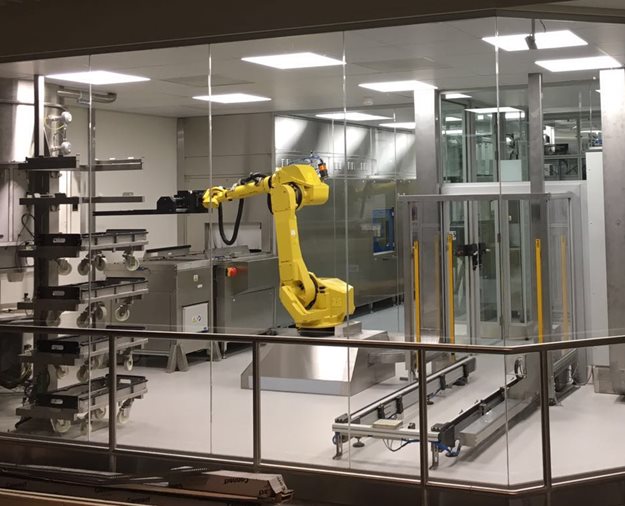
The animal research cage cleaning robot
“As for the latter, how do you ensure that? I mean, how do you know the animals, and especially small animals like mice and rats, are happy or not?”
He smiles and opens the door of one the many rooms in the hallway.
“That’s a very good question, which can perhaps be better answered by one of our excellent biotechnicians: Floor Moonen!”
Floor: “To measure and quantify the level of discomfort and pain, for example, we use the grimace scale (GS) score. We carefully observe animals’ facial expressions, and their overall behavior to assess whether the animal is happy or is suffering discomfort.”
“And what other roles do you have?”
“Oh, that’s quite a lot actually, and that makes my job diversified! I take care of the animals on daily basis, I apply injections, plan experiments, and I’m involved in the evaluation of animal experiment applications.”
“So, you’re quite involved in the complete process of animal experimenting?”
“That’s true”
After some talking, we thanked Floor and left her alone with her preparations. Otto shows me couple of other imaging rooms, such as the fluorescence room, the PET/CT scanners, the high-resolution SPECT-scanner, and the MRI scanners. We then make our way back to the office.
“I heard that you are providing trainings in animal research, is that correct?”
“Indeed! For those interested in executing experiments with laboratory animals we organize a course 5 times a year on laboratory animal science (LAS). After passing the exam, investigators can get registered to design and carry out experiments with laboratory animals. For a new set of experiments investigators submit a license application to the central committee on animal Experiments. The Animal Welfare Body (AWB) assists investigators to apply for such a license. When the license has been obtained, the Animal Welfare Body will check the details of the protocol of the experiment. The details of these procedures can be found on our website.
In case investigators need more information about our facility, they can check our website or contact our team via e-mail (Postbus Helpdesk Centraal Dierenlaboratorium/helpdesk.cdl@radboudumc.nl) of phone (024-361500).”
We’re back at Otto’s room. And before I wrap up and leave, there is still one urging question I want to ask:
“Thank you for showing me the facility. However, I am still curious, why we still need animals to do research? Do you think we can one day do science without animals?”
“You ask me whether I can see the future. I cannot. Fortunately, though, we can answer more and more questions without the use of laboratory animals. We do see a clear decrease in the number of animal experiments. What was once 25k a year 20 years ago, has now dropped to 10k. Of course, this can still be considered as too much, but in some aspects of scientific research we don’t have suitable alternatives. Another positive development is that we are able to extract more data from a single animal, through the use of advanced imaging techniques, which can help us to answer more questions.”
“But doesn’t that also mean that the animal suffers more discomfort?”
“Very good point! The animals are not necessarily experiencing more distress due to the increased data collection. It is important to note that we are implementing more sophisticated methods to reduce the level of distress. Although PET, SPECT or MRI scans require the animal to be under anesthesia for about 10 to 30 minutes, it is a less invasive alternative to procedures such as taking biopsies or euthanizing the animal for tissue study. With this state-of-the-art equipment we also acquire much more high-quality data from the animals.”
“I have one final, moral, question. I’ll then leave you. One of the main arguments against animal research, is that it’s still revolves around (the interests of) humans, and about our relationship with animals. Whether it is up to humans to decide on the fate of laboratory animals. How do you see this?”
“That's true, and therefore we have a huge responsibility to do our utmost to minimize the discomfort of animals during the experiments. In addition, we do our utmost to further improve the quality of the animal experiments in our facility, resulting in high quality results.”
“Otto, thank you again for receiving me, and for allowing us to have a glimpse of the CDL and the RTC Animal Research Facility. I thoroughly enjoyed our conversation and appreciate your transparency about the procedures.”
This concludes another RTC blog-interview. It seems that animal research holds significant value for scientific research and is expected to remain so for the foreseeable future. However, it's reassuring to witness efforts toward transparency in procedures and minimizing animal discomfort. This is a topic that requires ongoing critical debates and dialogues, and perhaps this interview can serve as a modest contribution to that discourse. I hope to be with you in the next blog. Take care!
Text continuous after image 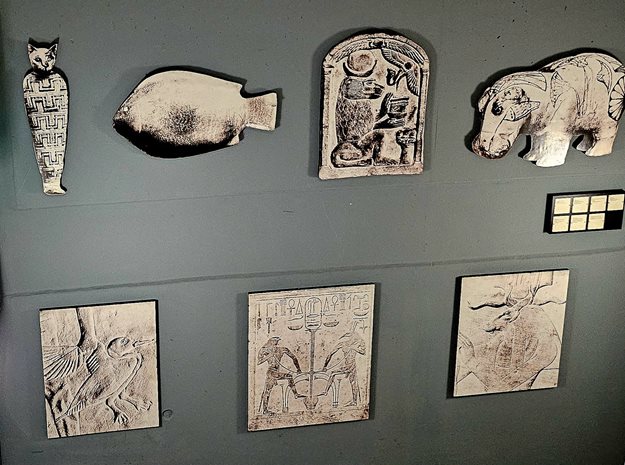
A collection of animal artworks in old-Egyptian style hanging as wall decorations in the stairwell of the CDL building
-
Interview by Hasan Erkan (email)
Editor Radboudumc Research Newsletter
You can find all editions of our blog series on this page






